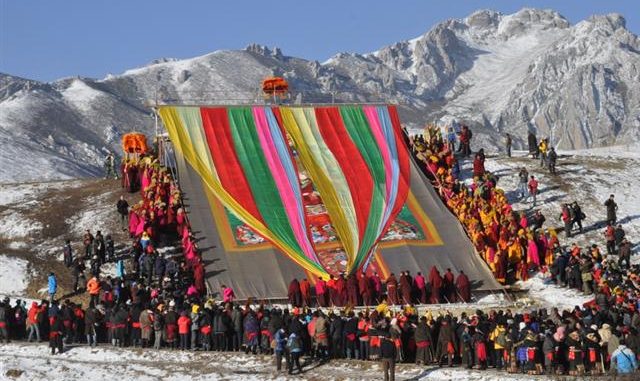Verses of the Eight Noble Auspicious Ones
By Mipham Rinpoche
*Note
It is very important to recite this through once before starting on any activity; whatever the project, it will work out exactly as you wish.
Om, nangsi namdak rangshyin lhundrubpe
Om! Homage to the Buddha, Dharma and Noble Sangha
Tashi chok chu shying na shyukpa yi
All that dwell in the auspicious realms of the ten directions,
Sangye cho dang gendun pakpe tsok
Where appearance and existence is completely pure, its nature spontaneously perfect,
Kun la chaktsal dakchak tashi shok
May everything be auspicious for us all,
Dronme gyalpo tsalten dondrup gong
Dronme Gyalpo, Tsalten Dondrup Gong,
Jampe gyen pal gedrak paldampa
Jampe Gyen Pal, Gedrak Paldampa,
Kunla gongpa gyacher drakpa chen
Kunla Gongpa Gyacher Drakpa Chen,
Lhunpo tar paktsal drakpal dang ni
Lhunpo Tar Paktsal Drakpal,
Semchen tamchela gong drakpe pal
Semchen Tamchela Gong Drakpe Pal,
Yitsim dzepa tsal rab drakpal te
Yitsim Dzepa Tsal Rap Drakpal Te,
Tsen tsam tope tashi pal pelwa
Homage to you, the Eight Sugatas,
Dewar shekpa gye la chaktsal lo
Merely hearing your names increases auspiciousness and success,
Jampal shyonnu palden dorje dzin
Youthful Manjusri, glorious Vajrapaṇi,
Chenrezik wang gonpo jampe pal
Lord Avalokitesvara, protector Maitreya,
Sa yi nyingpo dribpa nampar sel
Ksitigarbha, Sarvanīvaraṇaviṣkambhin,
Namkhe nyingpo pakchok kuntuzang
Akasagarbha, and Samantabhadra noblest of all,
Utpal dorje pekar lushing dang
Utpala flower, vajra, white lotus, naga-tree,
Norbu dawa raldri nyima yi
Jewel, moon, sword and sun,
Chaktsen lek nam tashi pal gyi chok
Gracefully holding your emblems, and supreme in granting auspiciousness and success,
Changchub sempa gye la chaktsal lo
Homage to you, the Eight Bodhisattvas,
Rinchen duk chok tashi ser gyi nya
The most precious umbrella, the auspicious golden fishes,
Do jung bum zang yi ong kamala
The wish-fulfilling vase of goodness, the exquisite kamala flower,
Nyendrak dung dang püntsok pal be'u
The conch of fame and glory, the glorious knot of prosperity,
Minub gyaltsen wanggyur khorlo te
The eternal banner of victory and the all-powerful wheel,
Rinchen tak chok gye kyi chaktsen chen
Holding these eight most precious emblems,
Chok du gyalwa cho ching gye kyema
Are the creators of delight, making offerings to the buddhas of all directions and times,
Gek sok ngowo drenpé pal pelwe
Homage to you, the Eight Auspicious Goddesses—Beauty, Garlands, Song, Dance, Flowers, Incense, Light and Perfume,
Tashi lhamo gye la chaktsal lo
Merely thinking of you makes success grow more and more,
Tsangpa chenpo dejung semebu
Mighty Brahma, Siva and Visnu,
Mik tong den dang gyalpo yulkhor sung
Indra the thousand-eyed, the kings Dhṛtarastra,
Pak kyepo dang luwang mikmizang
Virudhaka, Virupakṣa the lord of nagas,
Namtose te lhadze khorlo dang
And Vaisravaṇa—each one holding your divine emblem,
Trishula dang dungtung dorje chen
Wheel, trident, lance, vajra,
Piwam raldri choten gyaltsen dzin
Viṇa, sword, stupa and banner of victory,
Sa sum ne su gelek tashi pel
Homage to you, the Eight Guardians of the World,
Jikten kyongwa gye la chaktsal lo
Who make auspiciousness and positivity grow in the three realms,
Dakchak deng dir jawa tsompa la
With all obstacles and harmful influences pacified,
Gek dang nyewar tsewa kun shyi ne
May the work we are now about to begin,
Dodon pal pel samdon yishyin drub
Meet with ever-growing fulfilment and success, and,
Tashi delek punsum tsokpar shok
Bring good fortune, prosperity, happiness and peace.
*Note
Recite this prayer when you wake up, and you will accomplish all your aims for the day. Recite it when you go to sleep, and you will have good dreams. Recite it before a conflict, and you will be completely victorious.
Recite it when you embark on any project, and you will be successful. If you recite this prayer every day, the length of your life, your splendour, renown, and wealth will all increase, you will find perfect happiness, you will accomplish your aims exactly as you wish, all harmful actions and obscurations will be purified and all your wishes for higher realms, liberation and omniscience will be fulfilled.” These are the words of the Buddha himself.
This prayer arose from the lake of Jampal Gyepe Dorje’s mind on the third day of the third month of the Fire Monkey year (1896), an auspicious time according to the configuration of planets, sun and constellations.
Vajrayana features countless skillful and powerful methods which, if they are practiced in the proper way, can make the process of accumulation and purification incredibly swift and direct. It is absolutely necessary to have the pure motivation and to know that Vajrayana practice is not carried out to increase one’s own ego, power and self-interests.
Do you earnestly cherish our devoted work? Assuming this is the case, we are delighted that you are finding our blog useful and valuable. Would you consider making a donation for our Buddhist research and development?
We need your help to secure the future of scholarly interaction with Buddhism. Since our very first publication of Dharma works and activities in the year 2008, we had been effortlessly providing free distribution of Dharma posts and articles throughout the previous 10 years.
We have exceptionally constrained supports and do not receive subsidized or funding from people in general.
Please help us and to develop our Dharma activities that will not only benefit you, but to all Dharma readers on the planet. Please consider showing your support. Your generosity will certainly help us to enhance our work and to accomplish for a better and brighter prospect to come.
Thank you for reading, may you find peace and great bliss. With your support it helps to spread the Buddha’s precious teachings and turning the Dharma wheels in the world.
Aspiration For Bodhichitta
For those in whom the precious Bodhichitta has not arisen
May it arise and not decrease
But increase further and further.
Dedication of Merit
By this merit may we obtain omniscience then.
Having defeated the enemies wrong-doings.
May we liberate migratory from the ocean of existence.
With its stormy waves of birth, old age, sickness and death.
*Note
I do not own or infringe any copyright of the picture(s).
Picture(s) courtesy and credit to the rightful distributors and or studios.
Picture(s) is/are intended for editorial use only.





































